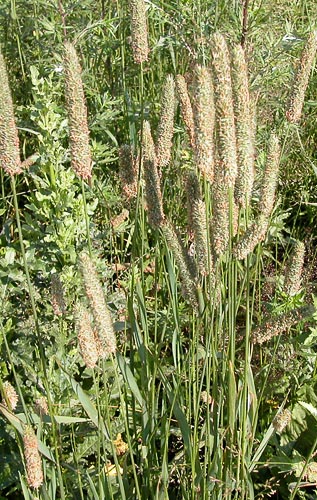Crops
Phleum pratense L. - Timothy, cat.s-tail, herd.s grass.
Taxonomic position.
Family Poaceae Barnhart., genus Phleum L.Biology and morphology.
Chromosome number: 2n = 14, 28. Perennial plant, robust, hairless, cespitous. Root system is well developed, penetrating to depths of 120 cm. Stems erect, hollow, cylindrical, 20-140 cm tall, often bulging at the base and forming a small bulb. Blade rolled when young, large (4-9 mm), flat, slightly rough on the margin, rather long (reaching 35 cm), pale green to greyish-green. Ligule strong (reaching 6 mm (long), obtuse, white. No auricles. Spike-like particle, cylindrical, 5 - 12 (- 30) cm long. Spikelets 1-flowered. The weight of 1000 seeds is 0.4 to 0.8 g (small seeds). Vegetation period is 85-130 days. Cross-pollinated by wind.Distribution.
Introduced into the culture in the 18th century. Cultivated on large plots in forest, steppe and mountain areas in 94 regions and republics of the former USSR. 71 breeding cultivars for forage and pasture purposes are utilized under state sanction.Ecology.
Mesophyte, adapted to wide climate range, but its cold resistance makes it a very useful forage plant in northern mountain areas. Originally from cold, cool and rainy climates. Sensitive to drought. Optimum growth occurs in drained to cool soils. Thrives in rich to very rich soils that are slightly acidic to alkaline. Grows often in soils rich in organic matter. Largely indifferent to soil texture. Less frequently found in dry sands. Thrives in peat soils if they are not too wet (boggy). Some forms tolerate water-logging.Utilization and economic value.
An excellent forage and pasture grass. Good palatability by cattle, sheep, goats and horses. High-yielding in mixtures with Trifolium pratense, sometimes with perennial grasses. Used for hay, haylage, silage, especially grass-legume silage, and grazing. Used for erosion control. Forage mass productivity ranges from 40-50 MT/ha; hay productivity ranges from 2.5-13.0 MT/ha. Seed productivity is 200-1200 kg/ha.References:
Catalog of state permitted cultivars of agricultural crops. 1969. - M.: Kolos, 489 pp. (in Russian).Catalog of state permitted cultivars of agricultural crops. 1971. - M.: Kolos, 488 pp. (in Russian).
Catalog of state permitted cultivars of agricultural crops. 1974. - M.: Kolos, 480 pp. (in Russian).
Catalog of state permitted cultivars of agricultural crops. 1985. - M.: Kolos, Vol 3. - 489 pp. (in Russian).
Catalog of agricultural crops. cultivars permitted in Byelorussia. 1985. - Minsk: Uradjai, 176 pp. (in Russian).
Golovkin B.N. 1988. Cultigenic plant area. - M.: Nauka, 184 pp. (in Russian).
Medvedev P.F., Smetannikova A.I. 1981. The forage crops of European part of the USSR. 1981. - L.: Kolos, 336 pp. (in Russian).
Shashko D.N. 1967. Agroclimatic region of the USSR. - M.: Kolos, 335 pp. (in Russian).
Shashko D.N. 1985. Agroclimatic resources of the USSR. - M.: Kolos, 248 pp. (in Russian).
Soil resources of the USSR (Agricultural regions of areas and republics of USSR). 1990. M.: - Vol 1. - 260 pp. (in Russian).
State register of Ukrainian plant cultivars. 1992. - Kiev: Urojai, 199 pp. (in Russian).
State register of breeding achievements permitted for utilization. Plant cultivars. 1994. - M.: - 218 pp. (in Russian).
State register of breeding achievements permitted for utilization. Plant cultivars. 1996. - M.: - 171 pp. (in Russian).
State register of breeding achievements permitted for utilization. Plant cultivars. 1999. - M.: - 192 pp. (in Russian).
State register of breeding achievements permitted for utilization. Plant cultivars. 2000. - M.: - 232 pp. (in Russian).
State register of breeding achievements permitted for utilization. Plant cultivars. 2001. - M.: - 252 pp. (in Russian).
State register of breeding achievements permitted for utilization. Plant cultivars. 2003. - M.: - 236 pp. (in Russian).
The Natural-agricultural regions and utilization of soil resources of the USSR. A.N. Kashtanov (ed.). 1983. - M.: Kolos, 336 pp. (in Russian).
The register of plant cultivars in Ukraine. 1996. - Kiev: Urojai, 259 pp. (in Russian).


